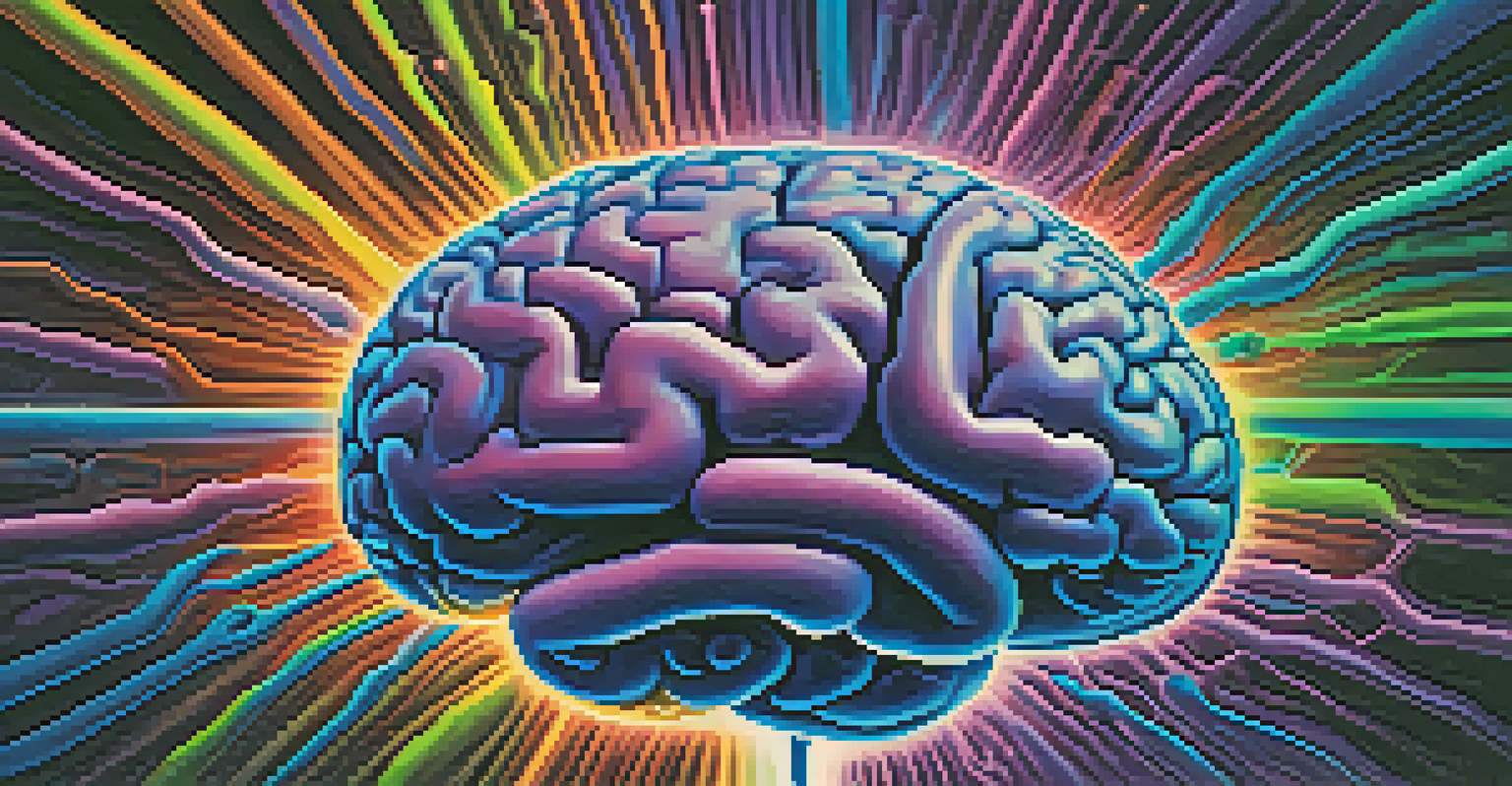The Mechanisms of Action: How Entheogens Alter Consciousness

What Are Entheogens and Their Historical Use?
Entheogens are substances that can induce altered states of consciousness, often used in spiritual or religious contexts. Historically, cultures around the world have utilized these plants and compounds to connect with the divine or explore the self. For instance, indigenous groups in the Amazon have long used ayahuasca for healing and spiritual guidance, showcasing the deep-rooted traditions surrounding these substances.
Psychedelics are a unique tool for exploring the depths of the mind, allowing individuals to confront their inner fears and emerge with a fresh perspective.
These substances include a range of psychedelics, such as psilocybin mushrooms, peyote, and LSD. Each has its unique effects, but they all share the ability to alter perception and cognition. The term 'entheogen' itself comes from Greek, meaning 'generating the divine within,' emphasizing their use in spiritual exploration.
As modern research continues to unveil their potential, entheogens are gaining attention for their therapeutic benefits, particularly in treating mental health issues. The blend of tradition and science creates a fascinating narrative, inviting us to explore how these compounds can transform our understanding of consciousness.
How Entheogens Interact with the Brain
At the core of how entheogens alter consciousness is their interaction with neurotransmitters in the brain, particularly serotonin. Many psychedelics act as agonists for serotonin receptors, especially the 5-HT2A receptor, which plays a crucial role in mood and perception. This interaction can lead to heightened sensory experiences and altered thought patterns, providing users with a different perspective on reality.

For example, when someone consumes psilocybin, the active compound in magic mushrooms, the brain's default mode network (DMN) shows decreased activity. The DMN is associated with self-referential thoughts and the 'ego.' By quieting this network, users often report feelings of unity and interconnectedness, altering their perception of self and the world.
Entheogens and Spiritual Connection
Entheogens have been historically used in various cultures to induce altered states of consciousness for spiritual exploration and healing.
Additionally, entheogens can promote neuroplasticity, the brain's ability to reorganize itself by forming new neural connections. This characteristic is particularly promising for therapeutic applications, as it suggests that psychedelics could help individuals break free from ingrained patterns of thought and behavior.
The Role of Set and Setting in Experience
An essential aspect of using entheogens is the concept of 'set and setting,' which refers to the mindset of the user (set) and the physical and social environment (setting) in which the experience occurs. Both elements significantly influence the nature of the psychedelic experience. A positive mindset and a comfortable setting can lead to profound insights, while a negative mindset or an uncomfortable environment can lead to anxiety or distress.
The experience of entheogens is one of the most transformative journeys one can undertake, often leading to a profound sense of interconnectedness with all of existence.
For instance, someone who approaches a psychedelic experience with curiosity and an open heart is more likely to have a transformative journey. On the other hand, if they are feeling anxious or pressured, the experience may be less positive. This highlights the importance of preparation and intention when using these substances.
Moreover, creating a supportive environment—whether that means having trusted friends nearby or being in a serene nature setting—can enhance the experience. This is why many modern therapeutic sessions involving psychedelics take place in controlled environments with trained facilitators, ensuring a safe and supportive atmosphere.
Psychedelics and Emotional Healing
Recent studies have shown that entheogens can have profound effects on emotional healing, particularly for those dealing with trauma or depression. By allowing users to confront difficult emotions in a new light, these substances can facilitate catharsis and insight. For example, many who have participated in guided psilocybin therapy report significant reductions in anxiety and depression, often after just a few sessions.
The experience can help individuals reprocess traumatic memories, providing a sense of release and understanding. This therapeutic potential is being explored in clinical settings, where researchers are investigating how psychedelics can complement traditional therapies.
Therapeutic Potential of Psychedelics
Research indicates that entheogens can significantly aid in emotional healing and mental health treatment, particularly for trauma and depression.
Additionally, entheogens can foster feelings of empathy and connectedness, which are crucial for emotional healing. Users often describe a newfound appreciation for life and relationships post-experience, indicating that these substances may not only heal individual wounds but also promote a sense of community and connection.
Exploring Mystical Experiences with Entheogens
Many users report having mystical or transcendental experiences while under the influence of entheogens. These experiences often include feelings of unity with the universe, deep insights into one's life, and encounters with a sense of a higher power. Such experiences can lead to lasting changes in attitudes and behaviors, often promoting a more compassionate and open-minded outlook on life.
For instance, a study involving participants who took psilocybin found that many described their experience as one of the most meaningful of their lives. This suggests that entheogens can catalyze profound personal transformations, challenging our understanding of consciousness and spirituality.
The concept of non-ordinary states of consciousness, as experienced through entheogens, raises questions about the nature of reality and our place within it. As more individuals share their experiences, the dialogue around these substances continues to grow, inviting both skepticism and fascination.
Potential Risks and Considerations
While entheogens hold great promise for personal and therapeutic growth, they also come with potential risks. One significant concern is the potential for psychological distress, particularly for individuals with a history of mental health issues. It’s crucial to approach these substances with caution and ideally under the guidance of professionals.
Moreover, not all experiences with entheogens are positive. Users may encounter challenging emotions or thoughts, known as 'bad trips,' which can be distressing. This emphasizes the importance of set and setting, as well as having a trusted guide present during the experience to help navigate any difficulties.
Importance of Set and Setting
The user's mindset and the environment play crucial roles in shaping the psychedelic experience, influencing its positive or negative outcomes.
Education and harm reduction strategies are vital for anyone considering the use of entheogens. Understanding the effects, potential risks, and the importance of a supportive environment can help ensure that the experience is both safe and beneficial.
The Future of Entheogen Research and Acceptance
As interest in entheogens continues to rise, so does the potential for groundbreaking research. Studies focusing on their therapeutic benefits are gaining momentum, with institutions exploring their efficacy in treating PTSD, addiction, and anxiety disorders. The results so far are promising, showcasing how these substances can offer new avenues for healing.
Additionally, societal attitudes towards psychedelics are slowly shifting. As more people share their positive experiences and scientific research backs these claims, entheogens are becoming more accepted in mainstream discussions about mental health and spirituality. This shift could pave the way for legal reform and increased accessibility.

Ultimately, the future of entheogen research and acceptance lies in a balanced approach—recognizing their potential while also respecting the complexities involved in their use. By fostering informed conversations, we can ensure a thoughtful exploration of these powerful substances and their role in human consciousness.